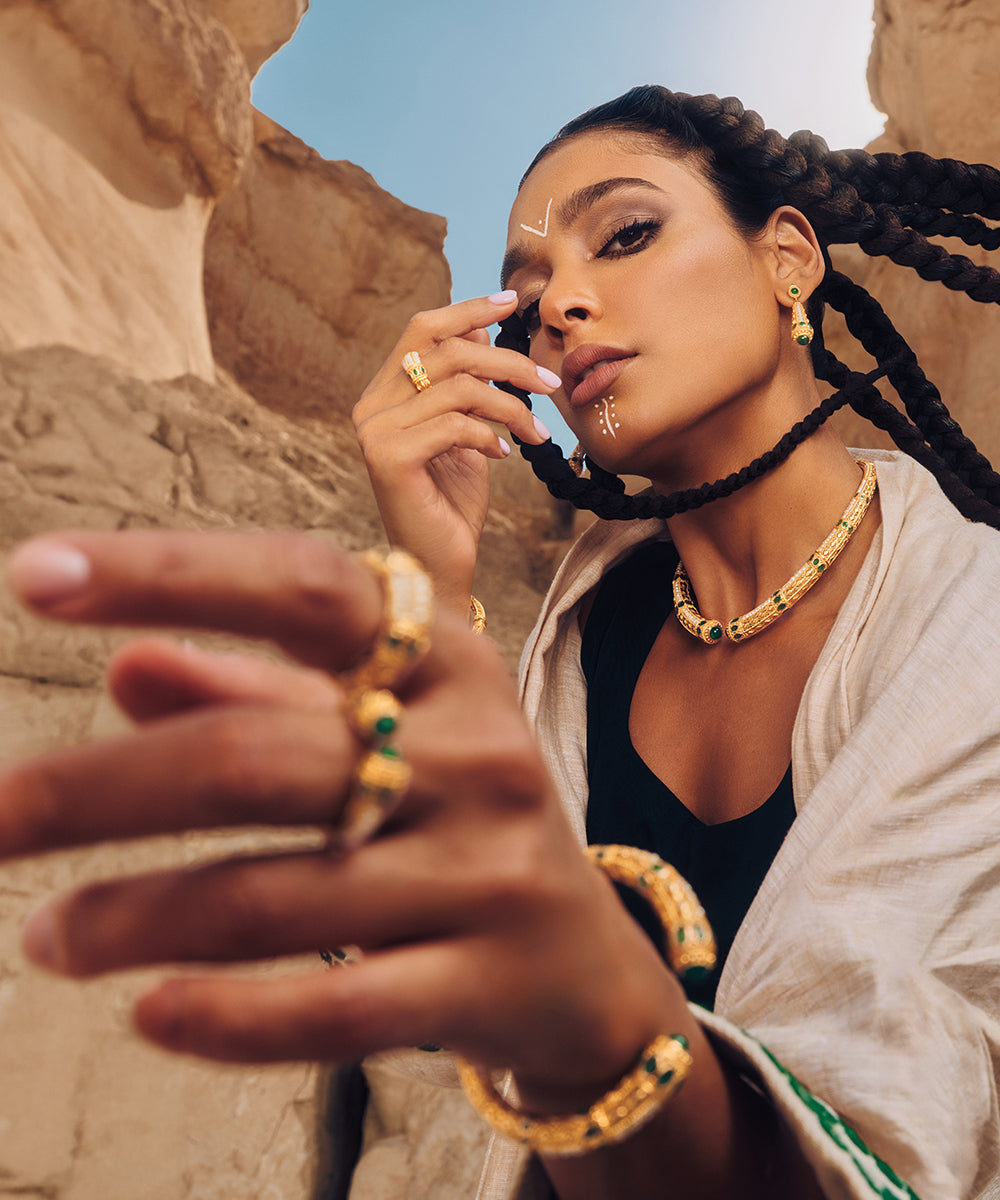pearl
Pearl is an organic, white to bluish grey colored, precious gemstone produced inside the body of a living organism called ‘Mollusc’. This gemstone holds a strong astrological significance in the Vedic astrology and is worn to pacify planet Moon in the wearer’s birth chart. Western astrology suggests Pearl birthstone for those born in the month of June.
History of Bahrain with Natural Pearls
Bahrain (the Arabian Gulf’s magical Island Kingdom and a true Garden of Eden) is the world’s premier location for natural pearls and is steeped in pearling history. Virtually every ancient author when describing the islands of Bahrain mentions the fine pearls found in its waters. Writing in the first century AD, Pliny (AD 23-AD 79) states that the pearl fisheries of Tylos (the classical name for Bahrain) were well known in his time, which in itself is remarkable, but diminishes into insignificance when one understands that the fisheries were known and revered when Bahrain was the seat of ancient Dilmun in the late fourth millennium to 800 BC. Indeed throughout known history the fisheries have been regarded as the most famous and most valuable in the world.
Nature's greatest wonder
It is a truly astonishing series of events that results in the creation of a nacreous or non-nacreous natural pearl. A natural pearl’s story begins within the mollusc’s mantle tissue – the protective membrane that secretes the biogenic substances that go towards the formation of the mollusc’s shell as well as the smooth nacreous inner lining of some shells through a process of biomineralisation. The mollusc, in a self-protective action, creates a pearl sac from and within the mantle tissue to wrap around and isolate some form of ‘irritant’ and in so doing secretes the layers of nacre (biomineralised calcium carbonate-CaCO3-, organic matter and water) or a non-nacreous crossed lamellar microarchitecture. The secreting of the nacre or non-nacreous materials over the ‘irritant’ sometimes (but not always) forms a lustrous nacreous or non-nacreous natural pearl. Most ‘precious’ natural pearls are nacreous and they are formed in bi-valve molluscs that inhabit both saltwater and freshwater environments. Sometimes, bi-valve molluscs produce valued non-nacreous natural pearls as do univalves. A pearl may be found still within its ‘sac’ (known as a cyst pearl) or, having broken out of the ‘sac’, attached to the inside surface of the mollusc’s shell (known as a blister pearl).
Types of Pearls
Natural pearls: natural pearls are produced entirely by nature, within a natural pearl sac and/or as a blister pearl adhering to the inner-side of the mollusc’s shell and can be formed in both freshwater and saltwater environments. They may be nacreous or non-nacreous.
Blister Pearls: A blister pearl is a natural pearl that has perforated the mantle of the mollusc and has naturally adhered, through layers of nacreous or non-nacreous secretions applied by the mollusc, to the inner wall of the shell.
The subsequently formed layers of nacreous or non-nacreous material are continuous with those of the inner wall of the shell.
They are round or irregular in shape and are secreted without human intervention. Blister pearls are known in the Arabian Gulf as “Nimro”.
The base of natural blister pearls may be worked.
Blisters: a nacreous blister, is an internal protuberance of the shell, which may be low or high domed, caused by the intrusion and trapping of foreign bodies between the mantle and the inner surface of the shell that have entered through the live opened shell or have bored through the shell from the exterior.
The interior of the blister may or may not contain the remains of a variety of skeletal, plant or mineral forms. Indeed, they are often hollow following the decomposition of an organic intrusion.
The secretion occurs naturally, without human intervention.
Cultured Pearls: Cultured pearls are formed in the interior of productive living molluscs within a cultured pearl sac with human intervention and a variety of conditions depending upon the mollusc and the goals.
Non-bead Cultured Pearls: Non-bead cultured pearls are produced by implanting multiple pieces of mantle tissue taken from one sacrificed donor mollusc, which eventually form cultured pearl sacs, into the mantle tissue of another living freshwater mollusc.
The cultured pearl sacs formed in this manner secrete nacre and eventually produce non-beaded freshwater cultured pearls.
Alternatively, non-beaded cultured pearls may form in saltwater molluscs following the accidental creation of cultured pearl sacs in or near the gonad of saltwater molluscs.
Bead Cultured Pearls: Bead cultured pearls are usually nacreous formations secreted in the interior of various saltwater and freshwater molluscs.
A bead is inserted into the mollusc along with a piece of mantle tissue which eventually forms the cultured pearl sac around the bead which is in turn responsible for the secretion of nacreous layers.
The outer layers of beaded nacreous cultured pearls are concentric and composed of a complex scleroprotein named “conchiolin”, water and of calcium carbonate (usually in the form of aragonite).
The bead cultured pearl may also be formed by placing a shell bead into a pre-used cultured pearl sac (2nd harvest) that remains in the gonad of the host mollusc.
Atypical Bead Cultured Pearls: Atypically, beads formed from natural or cultured pearls of various types or other materials may be used to create bead cultured pearls in the manner described above.
However, in such circumstances the product is described as containing an atypical bead or the type of bead is named, e.g., an “atypical bead cultured pearl”, a “turquoise bead cultured pearl” or a “coral bead cultured pearl”.
Cultured Blister Pearls: A cultured blister pearl is a cultured pearl that has perforated the mantle (freshwater) or the gonad cavity of the mollusc and has adhered, through layers of nacreous or non-nacreous secretions applied by the mollusc, to the inner wall of the shell.
The subsequently formed layers of nacreous or non-nacreous material are continuous with those of the inner wall of the shell. They are round or irregular.
Keshi Cultured Pearls: The term Keshi is an old Japanese trade name for a small saltwater natural or non-bead cultured pearl that is essentially baroque in shape. Today it is used almost exclusively as a trade term for a non-bead cultured pearl, hence “Keshi cultured pearl”.
Note: the term Keshi used without qualification has been misused and is not recommended terminology for any type of pearl product unless qualified with either ‘natural’ or ‘cultured’, whichever is appropriate.
Assembled Cultured Blisters: Assembled cultured blisters are assemblages of a purpose-grown cultured blisters which have been cut from their shell, the original bead upon which they grew being removed and the cavity filled with various types of man-made materials, and backed by a layer of shell, the assemblages being held together by an adhesive; commonly known as Mabe or Hankei and occur in both fresh and saltwater environments.Not to be confused with cut cultured pearl.
Imitation Pearls: Imitations of pearls are artificial products that only simulate the appearance of natural or cultured pearls. They include any product which has been artificially coated by natural or artificial substances, and which the outer layers are not secreted by natural or cultured pearl sacs in the interior of the productive molluscs.
Pearl Treatments
Treated natural pearls or cultured pearls have been altered by methods other than normal procedures (drilled, cut, faceted, carved, polished, buffed and/or cleaned) to change their colour, composition and/or appearance and/or durability.
Units of Weight
The weight of cultured pearls shall be expressed in momme, kan, liang, carats, or grams. The weight of a natural pearl shall be expressed in pearl grains, liang, carats or methgal a unit of weight used in the Arabian Gulf that is equal to 4.5 grams, note also the chaw and once-the-weight.
The formula given above is used only if more than one pearl is being assessed and the pearls are of uniform size. The Chaw price depends on the grade and type of the pearls. Lower quality pearls are calculated by Methgal.
Pinctada Radiat
Pinctada radiata is commonly known as the ‘Gulf pearl oyster’, a species of pearl oyster that thrives in the waters of the Arabian Peninsula due to the unique environment conditions of the region.
The oyster is typically between 50 and 65 millimetres in length, though it can reach 106 millimetres. The shell is, thin, compressed, and square-like, with growth rings and ribs on the top surface. The colouration of the oyster varies but is usually brown or red on the exterior with a pearly interior and a light brown edge.
Size: separation of natural pearls is done by the use of different size graduated sieves. These are sorted into different sizes from the Ras, Batin, Thayl, Rubaa and Bukka and finally Sihteet.
Shape: pearls are classified into classic, semi-classic and circle shapes. This includes a wide range of shapes including round, near-round, oval, drop, button, near-baroque and baroque. In the Arabian Gulf and India, the traditional names are still used for such shapes in the local market and these are declared in table (1).
Colour: natural pearls from the Arabian Gulf have a wide range of colours and distinctive traditional trade names.
| White | Abyadh | ||
|---|---|---|---|
| Dull White | Basali | ||
| Black | Aswad | ||
| Cream with a reddish overtone | Nabati | ||
| White with a pinkish overtone | Mushayer | ||
| Whitish-blue or Whitish-grey | Singbassi | ||
| White or cream with a bluish overtone | Samawi | ||
| White with strong iridescent colours or 'orient' | Gallabi | ||
| White or cream or whitish-blue with high lustre | Alzujaji | ||
| Rose pink | Wardi | ||
| Light Yellow | Ashgar | ||
| Cream | Keremi | ||
| White or cream with a strong green overtone | Akgthar |
Lustre: is mostly judged by the sharpness of the reflection of light on the surface of the pearl which ranges from dull to very bright. In the Arabian Gulf, certain terminologies are used to grade the pearl’s lustre
| Jiwan* "meaning beauty in India" | Excellent perfect lustre | ||
|---|---|---|---|
| Shireen* "meaning sweet in India" | Very good lustre | ||
| Gholwah* "rounded pearls" | Average lustre form | ||
| Badlah "irregular pearls" | Poor to average lustre |
Surface: the surface grade of pearls is based on the type of surface characteristics including the size and location of the blemishes, surface discolouration, chips, pits and dimples, cracks and surface scratches. The surface grading ranges from clean to heavily blemished
| Clean | Surface free from blemish | ||
|---|---|---|---|
| Lightly Blemished | Surface with minor issegularities | ||
| Moderatley Blemished | Surface showing noticeable surface irregularities | ||
| Heavily Blemished | Surface showing obvious surface irregulation |
Peal Doctor
Most of the pearls are in perfect condition when they are first gathered from their oyster shells. However, a few become injured with the sharp knife used when opening shells. Such pearls need the expertise of a pearl doctor or in more simple terms, the cosmetic surgeon of pearls. He can detect the faults on the outer layer of pearls and decide whether they need to be worked to get a better and more valuable pearl, sometimes ten times the price of the original pearl.
About Danat
The Bahrain Institute for Pearls and Gemstones (DANAT) was established in 2017, at the instigation of HRH Prince Salman bin Hamad bin Isa Al Khalifa, Crown Prince, Deputy Supreme Commander and First Deputy Prime Minister of the Kingdom of Bahrain. DANAT was formed as a wholly owned subsidiary of the Bahrain Mumtalakat Holding Company, the sovereign wealth fund of the Kingdom, with the vision to become the world’s preferred institute for natural pearl and gemstones third party verification services and scientific research.
DANAT plays a vital role in protecting and enhancing public trust in pearls, gemstones and jewellery. It is an authority on industry standards, scientific knowledge and education, and is committed to the highest standards of professional and personal ethics. DANAT is dedicated to supporting the pearl and gemstone industry. It offers training programmes locally, regionally and internationally to a new generation of gemmologists, industry professionals and gemmology enthusiasts.
Danat's Services
DANAT’s services cover three main areas; the issuance of authentication reports for pearls and gemstones, gemmological research and the provision of gemmological training courses.
Verification and Authentication Testing Process
From the point at which pearls are received by DANAT, they are treated with the care and reverence deserved by such rare and beautiful examples of nature’s bounties. A client’s trust in DANAT’s ability to care for their valuables is critical for the execution of the test methods applied as part of the identification process.
Pearls submitted to DANAT’s client service representatives for identification are handled with care and registered in DANAT’s ‘intake’ system. Information about the pearls is initially gathered by DANAT’s experienced staff in the weights and measures department as well as DANAT’s photography department. The pearls then enter the Laboratory and undergo comprehensive identification testing.
The test methods applied to pearls may include three or more of the following:
• Microscopy
• Real time x-microradiography
• X-ray fluorescence imaging
• Micro CT
• Raman spectrometry
• Energy dispersive x-ray florescence (chemistry)
• Laser ablation ICP MS (chemistry)
• UV/visible spectroscopy
Authentication Reports
DANAT offers a variety of verification and authentication reports for pearl, gemstone and jewellery items designed to meet client requirements.
Micro-Card Report
The Micro-Card Report is specifically designed to provide a basic summary of their pearl. The information is presented in an easy-to-understand tabulated format and complemented by colour images of the pearl.
Standard Pearl Indentification Report
This report is one of the most comprehensive of its type and details all aspects of the item’s examination. It can also include origin determination. The report is presented in a high-quality hard-backed cover and produced in one of two formats. It is accompanied by a Micro-Card Report.
Supreme Report
The Supreme Report is designed for high quality items requiring a more prestigious presentation of the results detailed in the Standard Pearl Identification Report.The report is presented in a luxurious trifold folder containing the Standard Pearl Identification Report, a high quality enlarged image of the item and a letter that describes the item’s relevance to the market
Premium Report
The Premium Report is the most prestigious and comprehensive authentication report offered by DANAT. The report, tailored for items that are unique and of significant historical value, provides scientific verification of the pearls, detailing the testing process and the item’s precise history from its point of origin onwards. The Premium Report content is presented in a hand-crafted leather boxed creation, which alongside the precious item, can be treasured.



